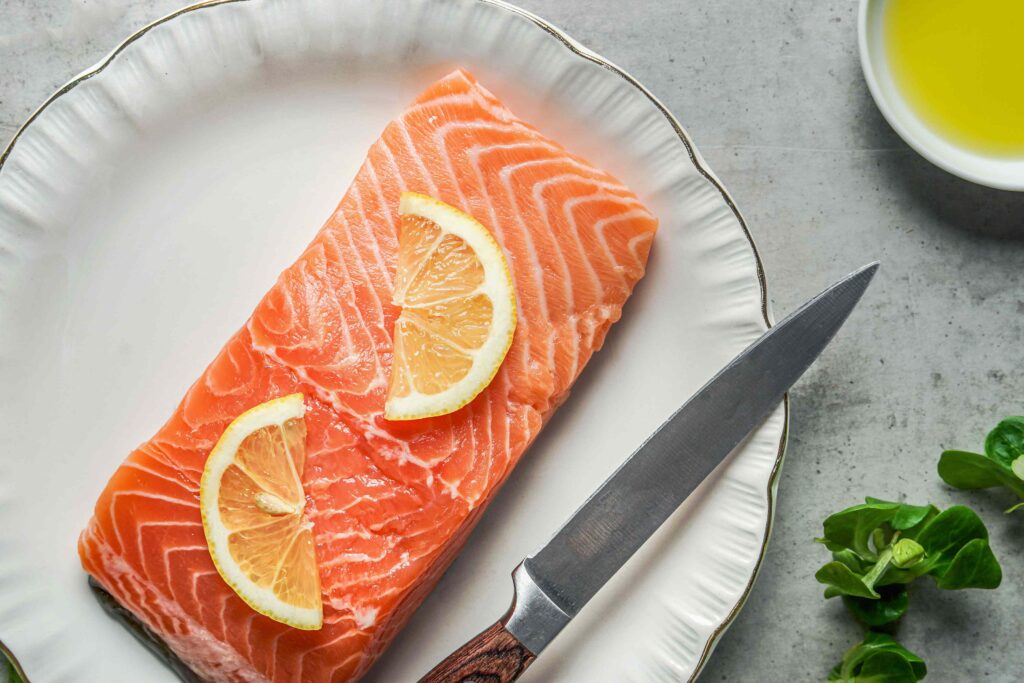Fish are rich in protein, omega-3 fatty acids, vitamin D, and minerals like iodine and selenium. However, they can contain varying amounts of mercury, a heavy metal. Healthier fish options are those that are nutrient-rich but lower in mercury.
Delia Pirvu / Getty Images
Salmon is one of the best sources of omega-3 fatty acids (omega-3s). Your body needs omega-3s to support healthy cell function, hormone production, immunity, and brain, eye, and heart health.
Three ounces (85 grams) of cooked Atlantic wild salmon contains:
- Calories: 155 kcal
- Protein: 21.6 grams (g)
- Fat: 6.9 g
- Omega-3 fatty acids: 1.8 g
Other fish high in omega-3s include mackerel, herring, sardines, trout, and anchovies.
Eating fish or taking omega-3 fatty acids is linked to a lower risk of heart disease. The American Heart Association (AHA) recommends eating two to three servings of fish each week to support heart health.
Javier Zayas Photography / Getty Images
Sardines are rich in protein and omega-3 fatty acids. They are also low in mercury.
Mercury is a heavy metal that can harm your health if eaten in large amounts. It is found in the environment, including oceans and freshwater, so fish contain it too.
Mercury levels in fish depend on where they live, what they eat, their species, age, and size. Some fish have more mercury while others have less.
A can (92 grams) of Atlantic sardines contains:
- Calories: 191 kcal
- Protein: 22.6 g
- Fat: 10.5 g
- Omega-3 fatty acids: 0.9 g
Health experts recommend eating fish regularly despite its mercury content. This is because the benefits outweigh the risks. Try choosing fish with low to moderate mercury levels.
Other fish lower in mercury include tilapia, anchovies, salmon, pollock, cod, sole, haddock, hake, whitefish, and scallops.
Fish higher in mercury include shark, swordfish, king mackerel, marlin, tilefish, and bigeye tuna.
Whitestorm / Getty Images
Tuna contains varying amounts of protein, omega-3s, and mercury. Skipjack tuna has one of the highest protein levels among fish and contains less mercury than other types of tuna.
Three ounces (85 grams) of cooked skipjack tuna contains:
- Calories: 112 kcal
- Protein: 24 g
- Fat: 1.1 g
- Omega-3 fatty acids: 0.2 g
Other fish that are higher in protein include cod, halibut, snapper, salmon, and sardines.
Fudio / Getty Images
Fish is one of the rare foods rich in vitamin D. Your body needs vitamin D for cell growth and repair, hormone production, bone health, and a strong immune system.
Greenland halibut is one of the richest sources of vitamin D. However, it is low in protein and relatively high in fat.
Three ounces (85 grams) of Greenland halibut contains:
- Calories: 158 kcal
- Protein: 12.2 g
- Fat: 11.7 g
- Omega-3 fatty acids: 0.8 g
- Vitamin D: 23 micrograms (mcg), or 116% of the Daily Value (DV)
Other fish high in vitamin D include salmon, mackerel, whitefish, trout, and cod.
Here are some tips to use when choosing fish:
- Check for freshness: Fresh fish should have a mild smell, firm flesh, no discoloration or dryness, and clear, shiny eyes. For frozen fish, choose packages that are fully sealed, without tears or large ice crystals.
- Opt for lower-mercury fish: Choose fish with low to medium mercury. This helps reduce your mercury exposure, especially if you eat fish often.
- Consider your goals: All fish have omega-3s in varying amounts, and their protein, fat, vitamin, and mineral content also vary. If your goal is to get the most omega-3s, choose fattier fish, like salmon. If your goal is to increase protein intake, choose leaner fish.
- Opt for healthy cooking methods: Grill, bake, or steam fish instead of frying to reduce added saturated fats. Cook fish to 145°F (63°C) to prevent foodborne illness.


